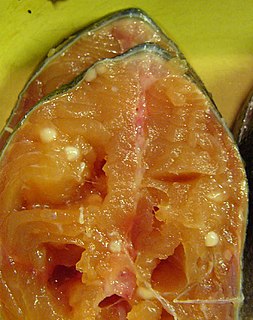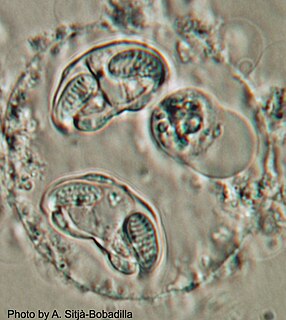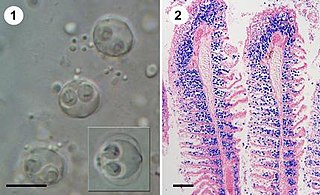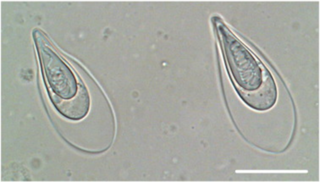
The Apicomplexa are a large phylum of parasitic alveolates. Most of them possess a unique form of organelle that comprises a type of non-photosynthetic plastid called an apicoplast, and an apical complex structure. The organelle is an adaptation that the apicomplexan applies in penetration of a host cell.

Myxozoa is an unranked subphylum of aquatic, obligately parasitic cnidarian animals and contains the smallest animals ever known to have lived. Over 2180 species have been described and some estimates have suggested at least 30,000 undiscovered species. Many have a two-host lifecycle, involving a fish and an annelid worm or a bryozoan. The average size of a myxosporean spore usually ranges from 10 μm to 20 μm, whereas that of a malacosporean spore can be up to 2 mm. Myxozoans can live in both freshwater and marine habitats.

Myxosporea is a class of microscopic parasites, belonging to the Myxozoa clade within Cnidaria. They have a complex life cycle which comprises vegetative forms in two hosts, an aquatic invertebrate and an ectothermic vertebrate, usually a fish. Each host releases a different type of spore. The two forms of spore are so different that until relatively recently they were treated as belonging to different classes within the Myxozoa.

Monogeneans are a group of ectoparasitic flatworms commonly found on the skin, gills, or fins of fish. They have a direct lifecycle and do not require an intermediate host. Adults are hermaphrodites, meaning they have both male and female reproductive structures.

Microsporidia are a group of spore-forming unicellular parasites. They were once considered protozoans or protists, but are now known to be fungi, or a sister group to fungi. They have recently been discovered to infect Coleoptera on a large scale, in a 2017 Cornell study. Loosely 1500 of the probably more than one million species are named. Microsporidia are restricted to animal hosts, and all major groups of animals host microsporidia. Most infect insects, but they are also responsible for common diseases of crustaceans and fish. The named species of microsporidia usually infect one host species or a group of closely related taxa. Approximately 10 percent of the species are parasites of vertebrates —several species, most of which are opportunistic, can infect humans, in whom they can cause microsporidiosis.

Henneguya zschokkei is a species of a myxosporean parasite of certain species of salmon of genus Oncorhynchus. It causes milky flesh or tapioca disease.
Capillaria philippinensis is a parasitic nematode which causes intestinal capillariasis. This sometimes fatal disease was first discovered in Northern Luzon, Philippines in 1964. Cases have also been reported from China, Egypt, Indonesia, Iran, Japan, Korea, Lao PDR, Taiwan and Thailand. Cases diagnosed in Italy and Spain were believed to be acquired abroad, with one case possibly contracted in Colombia. The natural life cycle of C. philippinensis is believed to involve fish as intermediate hosts, and fish-eating birds as definitive hosts. Humans acquire C. philippinensis by eating small species of infested fish whole and raw.
Ellobiopsis is a genus of unicellular, ectoparasitic eukaryotes causing disease in Gómez F, López-García P, Nowaczyk A, Moreira D (2009). "The crustacean parasites Ellobiopsis Caullery, 1910 and Thalassomyces Niezabitowski, 1913 form a monophyletic divergent clade within the Alveolata". Syst. Parasitol. 74 (1): 65–74. doi:10.1007/s11230-009-9199-1. PMID 19633933.. This genus is widespread and has been found infecting copepods from both marine and freshwater ecosystems. | classis = [[ parasitism has been seen to interfere with fertility in both sexes of copepods.

Huffmanela hamo is a parasitic nematode. It has been observed in the muscles of the dagger-tooth pike conger Muraenesox cinereus, a muraenesocid marine fish off Japan. Its life-cycle is unknown.
Gadimyxa atlantica is a species of parasitic myxozoan. Together with G. arctica and G. sphaerica, they infect Gadus morhua and Arctogadus glacialis by developing coelozoically in bisporic plasmodia in their urinary systems. These 3 species' spores exhibit two morphological forms: wide and subspherical, being both types bilaterally symmetrical along the suture line. The wide spores have a mean width ranging from 7.5-10μm, respectively, while the subspherical ones range from 5.3-8μm in mean width. The subspherical forms of Gadimyxa are similar to Ortholinea, differing in the development of the spores and in the arrangement of the polar capsules. Polychaetes Spirorbisspecies act as invertebrate hosts of G. atlantica.
Gadimyxa sphaerica is a species of parasitic myxozoan. Together with G. arctica and G. atlantica, they infect Gadus morhua and Arctogadus glacialis by developing coelozoically in bisporic plasmodia in their urinary systems. These 3 species' spores exhibit two morphological forms: wide and subspherical, being both types bilaterally symmetrical along the suture line. The wide spores have a mean width ranging from 7.5-10μm, respectively, while the subspherical ones range from 5.3-8μm in mean width. The subspherical forms of Gadimyxa are similar to Ortholinea, differing in the development of the spores and in the arrangement of the polar capsules.
Ceratomyxa gleesoni is a myxosporean parasite that infects gall-bladders of serranid fishes from the Great Barrier Reef. It was first found on Plectropomus leopardus.
Spinitectoides is a genus of parasitic nematodes, belonging to the family Cystidicolidae. Species of Spinitectoides are parasitic as adults in the gastrointestinal tract of fish. According to the World Register of Marine Species, the genus currently (2019) includes a single species, Spinitectoides berlandi.
Nematopsis (Nee-mah-top-cis) is a genus gregarine Apicomplexan of the family Porosporidae. It is an aquatic parasite of crustaceans with a molluscan intermediate host. Nematopsis has been distinguished from the similar genus Porospora by its resistant and encapsulated oocyst. Little molecular biology has been performed on the members of the Nemaptosis and species are described based on molluscan and crustacean hosts as well as oocyst structure. A total of 38 species have been described and are found all over the world.

Enteromyxum leei is a species of myxozoan, histozoic parasite that infects the intestinal tract and sometimes associated organs, like gall bladder and liver, of several teleostean fish species. Myxozoans are microscopic metazoans, with an obligate parasitic life-style. The parasite stages of this species live in the paracelullar space between fish enterocytes. It is the causative agent of enteromyxosis, or emaciative disease, also known as "razor blade syndrome" in sparid fish. E. leei has a wide host and geographical range within marine fish, and even freshwater fish have been infected experimentally. E. leei initially emerged in the Mediterranean in the late 1980s and it is believed to have been unintentionally introduced into the Red Sea. Its pathogenicity and economic impact depend on the host species. In the gilt-head seabream, it is manifested as a chronic disease that provokes anorexia, delayed growth with weight loss, cachexia, reduced marketability and increased mortality. In other species, it has no clinical signs. In sharpsnout seabream, infection results in very high mortality rates, which have pushed fish farmers to abandon the culture of this fish species.
Enteromyxum scophthalmi is a species of parasitic myxozoan, a pathogen of fish. It is an intestinal parasite of the turbot and can cause outbreaks of disease in farmed fish. It causes a cachectic syndrome characterised by loss of weight, muscle atrophy, weakness and fatigue.
Ichthyodinium chabelardi (/ɪkθioʊˈdɪniəm/) is currently the sole described species of the genus Ichthyodinium in the phylum Dinophyta, class Syndiniophyceae, order Syndiniales. It is of economic significance to the fish industry, where it depletes the numbers of many species of fin fish by acting as an endoparasite in host embryos. It was originally described in 1952 by Hollande and Cachon, who described it as an agent of infection amongst sardines off the coast of Algeria, in the Mediterranean Sea. In 2006, Gestal et al. proposed a reclassification of I. chabelardi into the genus Perkinsoide based on its ultrastructure and RNA sequence, but several papers have opposed this reclassification based on its zoospore ultrastructure, as well as its small subunit rRNA and large subunit rRNA sequences. Recently, there has been evidence brought forth that there may be at least two distinct species of Ichthyodinium, since slight genetic differences have been detected between the European and Asian populations. I. chabelardi is a generalist parasite with a very broad geographic range. It has been found in locations such as the coasts of Indonesia and Vietnam, the Mediterranean Sea, and off the coast of Portugal. The full extent of its distribution is not known. While it can be found throughout most of the year, it has been observed to infect sardine eggs with the highest rates in the winter and early spring, from December to March.

Sphaerospora molnari is a microscopic endoparasite of carp in pond cultures and natural freshwater habitats in Central and Eastern Europe. In natural infections, S. molnari invades the epithelia of gills and surrounding skin regions. It then forms spores in between epithelial cells, causing sphaerosporosis, a pathological condition of the skin and gill tissues. Affected tissues show marked dystrophic changes and necrosis, causing secondary bacterial infections and resulting in osmoregulatory and respiratory failure. Mortalities can reach 100% but little is known about the overall distribution of the parasite species in European carp ponds or its economic impact on carp aquaculture.

Thelohanellus kitauei is a myxozoan endoparasite identified as the agent of intestinal giant-cystic disease (IGCD) of common carp Cyprinus carpio. The species was first identified in Japan, in 1980 and later formally described by Egusa & Nakajima. Fan subsequently reported the parasite in China, and several other reports from carp and Koi carp in China and Korea followed. Reports referred to an intestinal infection, swelling and emaciation of fish due to blockage of the intestinal tract by giant cysts. The intestine of carp was believed to be the only infection site of T. kitauei until Zhai et al. reported large cysts of T. kitauei in the skin, with morphologically similar and molecularly identical spores. T. kitauei has been recognized as the most detrimental disease of farmed carp in Asia with around 20% of farmed carp killed annually. In 2014, the genome of T. kitauei was sequenced, and in 2016, its life cycle was found to include the oligochaete Branchiura sowerbyi. Infected oligochaete worms were first discovered in Hungary and raised concerns of the introduction of T. kitauei into European carp culture ponds, since it was believed to be endemic to Asia. However, the related disease (IGCD) has not yet been reported in Europe.









